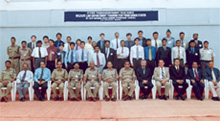|
For use of the media only;
not an official document.
PRESS RELEASE
Russian tiger goes to India courtesy of CITES
 |
| Click to enlarge the photo |
Geneva/New Delhi, 4 July 2002 - As a way of thanking the Sardar Vallabhbhai Patel National Police Academy of India for its recent cooperation in organizing an international training course for enforcement officials charged with protecting the wild tiger, the Secretary-General of the Convention on International Trade in Endangered Species of Wild Fauna and Flora (CITES) is sending a portrait of a Siberian tiger to the Academy's Director.
"The sale of this painting by the well-known Canadian wildlife artist Robert Bateman raised almost half of the funds needed for last month's vital training session on protecting the 5-7,000 tigers still living in the wild in Asia," said CITES Secretary-General Willem Wijnstekers. "The tiger's beauty and dignity come through powerfully in this portrait, and we see the painting's ability to help finance tiger protection, as well as its delivery to India, as a symbol of what police and enforcement agents throughout India and Asia are fighting for."
At the latest meeting of the Conference of the Parties to CITES, held in Kenya in 2000, Governments agreed to form a CITES Tiger Enforcement Task Force that brings together experts to help combat poaching and illegal trade in tigers. The Task Force identified training of law enforcement officials as a priority, since many of the officers in Asia who are tasked with protecting tigers and other species lack the specialized skills required to combat the organized criminal networks that engage in illegal wildlife harvesting and trade.
 Using guidance provided by the Tiger Enforcement Task Force, the CITES Secretariat prepared the programme for a two-week training event for enforcement personnel. The National Police Academy in Hyderabad, India agreed to host the course, and all tiger range States were invited to nominate students. The training took place at the Academy on 13-24 May 2002. Twenty-eight students attended from the following countries; Bangladesh, Cambodia, China, India, Indonesia, Lao People's Democratic Republic, Malaysia, Myanmar, Nepal, the Russian Federation, Thailand and Viet Nam. Using guidance provided by the Tiger Enforcement Task Force, the CITES Secretariat prepared the programme for a two-week training event for enforcement personnel. The National Police Academy in Hyderabad, India agreed to host the course, and all tiger range States were invited to nominate students. The training took place at the Academy on 13-24 May 2002. Twenty-eight students attended from the following countries; Bangladesh, Cambodia, China, India, Indonesia, Lao People's Democratic Republic, Malaysia, Myanmar, Nepal, the Russian Federation, Thailand and Viet Nam.
Responsibility for the training was divided between the Academy faculty and specialized instructors from the Secretariat, Africa, Europe and North America. The subjects covered included arrest techniques, border controls, CITES, covert operations, evidence gathering, fraud, forensic science, informants, interview techniques, intelligence, organized crime, personal safety, search and train-the-trainer. The training received high evaluation ratings from the students and the Academy. Together with written training materials, each student also received an electronic version of the presentations to enable him or her to conduct further training.
Approximately half of the funding needed to hold the course was raised by the Conservation Treaty Support Fund (CTSF), based in the United States. CTSF raised USD 42,000 through the sale of the Bateman tiger painting plus limited edition prints. It is a copy of this painting that the Secretary-General of CITES is now sending to the Director of the Academy. Additional funds came from the Government of the United Kingdom, the US Fish and Wildlife Service's Rhinoceros and Tiger Conservation Fund and the World Wildlife Fund (US) Species Conservation Program.
The students attending the course included Forest Police from China, three officers from the specialized Inspection Tiger Brigade in Vladivostok and five officials responsible for wildlife law enforcement from different parts of India. Specialist instructors included the senior wildlife crime prosecutor of the U.S. Department of Justice and an environmental crime officer from the National Police Agency of the Netherlands.
Note to journalists: A copy of the Secretary-General's letter to the Director of the National Police Academy is attached. For more information, please contact John Sellar at +41-22-917-8293 or john.sellar@unep.ch.
 To read previous press releases, go to Archives. To read previous press releases, go to Archives.
|